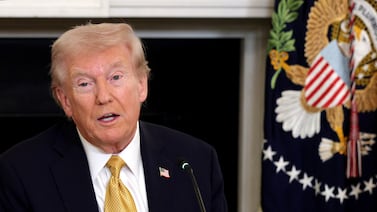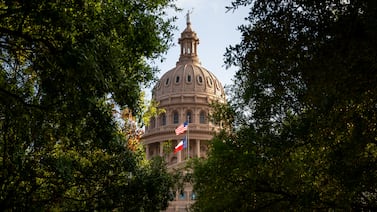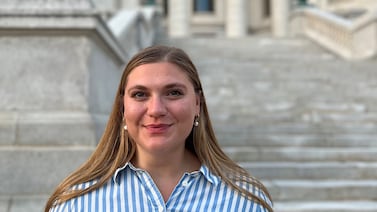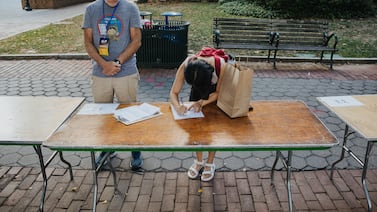Votebeat is a nonprofit news organization reporting on voting access and election administration across the U.S. Sign up for our free weekly newsletter to get the latest.
Progressives determined to defeat Donald Trump but unsatisfied with Kamala Harris’s position on the war in Gaza were offered an 11th-hour voting option this year: In October, a group called Swap Your Vote began offering to match voters in politically “safe” states with those in swing states.
The idea was that a prospective Democratic voter in a reliably blue state could instead cast a protest vote for a third-party candidate on behalf of their match in the swing state. The swing-state voter would feel like, through the trade, they were voting their conscience without putting their broader election aims at risk.
Such vote swapping isn’t new. In 2000, multiple sites popped up on the relatively new World Wide Web, connecting prospective Al Gore voters in solid Republican states with voters in swing states who wanted to vote for Ralph Nader.
This year, as in 2000, vote swapping didn’t generate a large volume of protest votes, and the Trump opponents failed in their broader aim to deny him a victory in the swing states. But voters who participated in vote swaps said it provided them with a useful outlet to cast a meaningful vote while remaining true to their core beliefs.
And in an election season defined by thin margins and vocal protest movements, it attracted attention. Talk-show host John Oliver mentioned the initiative on his program, and a state legislator from Georgia participated and encouraged others to follow suit. Organizers told Votebeat that around 15,000 people were matched through the program.
Supported by the liberal Landslide PAC and Movement Voter Project, Swap Your Vote matched swing-state voters with blue state voters by email, where the matched voters could introduce themselves and confirm their swap.
The initiative was launched by Rae Abileah, a 42-year-old based in the San Francisco Bay Area, who said it relied entirely on promises. “Ultimately when you go into that voting booth, you vote your own conscience and of your own free will, and no one is forcing you to do anything,” she said.
2024 voters were promised ‘double the protest votes’
In 2000, the draw for Nader supporters was that they could cast a ballot for Gore, the Democratic nominee, without feeling like they were abandoning their support for the Green Party.
This year’s initiative upped the ante: Each vote for Harris in a swing state was matched with two protest votes for third-party candidates in reliably blue states.
“That request really came from people on the ground, swing state voters who are in our social movements and who were saying it’s a big deal to ask them to vote for Harris,” said Abileah. “They get double the protest votes to really acknowledge that this is a heavy thing, to ask someone to vote for Harris in this moment.”
Worried that the election outcome might be decided by the Electoral College and not the popular vote, Abileah said she was spurred by a realization that “we need to vote strategically and stick together.” She collaborated with Andrew Boyd, a co-founder of Beautiful Trouble — a network of artists and activists working on grassroots movements— and Kipchoge Spencer, founder of Landslide PAC. They built a core team of around 40 volunteers, handling everything from posting on social media to matching up vote swappers and running the website.
Under the promised swap, the blue-state voter was to cast a protest vote based on the wishes of their swing state “swap buddy.” For instance, Abileah said, some people wanted a write-in vote for “No genocide” or “Arms embargo,” or even the name of the slain Palestinian poet Refaat Alareer, as their protest vote. Others listed a third-party candidate like the Green Party’s Jill Stein.
“One of the things that Swap Your Vote asked you to do, which is very hard in our day and age, is to trust that the other person is going to do what they say they will,” says the Rev. Michael Mulberry, a pastor in Michigan who had signed up on Swap Your Vote. Mulberry says he voted for Harris in the battleground state, while trusting his vote-swap partner to cast the protest vote for him.
But Mulberry said he got neither of the results he had hoped for. Trump beat Harris in Michigan, and every other swing state, to clinch the presidency. And the Green Party, which he supported, failed again to get 5% of the popular vote nationwide, which would have made the party eligible for federal funding. “So, I’m disappointed,” Mulberry said.
Laiken Jordahl, an environmental activist in Tucson, Arizona, also swapped his planned protest vote and cast his ballot for Harris instead. Despite his frustrations with the Democrats over their handling of the crisis in Gaza, Jordahl says he had felt that another Trump presidency “would be horrible for all of us — for immigrants, for the environment, and also, for the struggle in Palestine”.
Looking back at the election results, Jordahl said the vote-swapping initiative was “a really powerful effort,” but he wishes it had “started a month or two earlier.”
By the time Swap Your Vote got into full swing, the election was just about two weeks away, and many of the friends he had contacted about a vote swap had already voted early. “Had they known about this initiative, I think they may have changed their mind,” he said.
Indeed, for vote swapping to have the kind of impact participants look for, organizers would need “fairly large lead time” — rather than just a few weeks, said Mitchell Brown, professor of political science at Auburn University and the co-author of “How We Vote: Innovations in American Elections.” They would then “have to follow up with people closer to balloting to ensure that they actually cast their ballot.”
Vote-swapping sites protected by First Amendment — for now
In 2000, websites like vote-swap2000.com, votexchange2000.com, and NaderTrader.com launched in response to an article by constitutional law professor Jamie Raskin (now a U.S. congressman from Maryland), proposing vote swapping as a way to prevent protest votes from costing Gore the election.
The websites enabled third-party supporters in swing states such as Florida and Ohio to agree to be paired with major-party supporters in “safe states” such as Massachusetts or Texas.
Republican Bill Jones, who was California’s Secretary of State at the time, had threatened operators of the sites with criminal prosecution, claiming that what they were doing was similar to “vote buying” in violation of election laws. The creators of vote-swap2000.com and votexchange2000.com disabled their vote-swapping mechanisms but claimed in court that Jones' threatened prosecution violated their First Amendment rights.
Almost seven years later, the judges of the 9th U.S. Circuit Court of Appeals ruled that vote swapping was not the same as “buying” votes because no money or thing of value changed hands. The court further held the practice to be protected by the First Amendment.
But the legality of vote-swapping initiatives could yet be challenged, says Michael Morley, an election law professor at Florida State University’s College of Law.
“The Supreme Court has never directly addressed the issue,” Morley says — and neither have most of their federal appeals courts. Given that, while this precedent might be persuasive to the Court, “they are also free to reject it.”
Morley says swapping votes could be interpreted as “paying someone for their vote, whether you’re paying them in cash, services or through someone else promising to vote a particular way.” Thus, Morley cautioned, a court could reach a different conclusion than the 9th Circuit did in 2007.
Richard Hasen, director of the Safeguarding Democracy Project at UCLA School of Law, agrees that legal uncertainty hangs over vote-swapping. There’s an argument that exchanging votes is an exchange of value and a form of illegal vote buying, he said. But there are strong arguments to the contrary, he noted.
“A legislator cannot exchange anything of value for her vote on a bill, for example,” he explained. “But what if there’s horse trading between legislators — ‘I vote for your bill if you vote for mine?’ Some have argued that pure political exchanges should not be covered by bribery laws. One could say the same about vote swapping.”
Hasen added: “There’s also an argument that these are not enforceable contracts, and so that makes them not an agreement to engage in vote buying.”
Meghnad Bose and Uzma Afreen are freelance journalists based in New York City.




